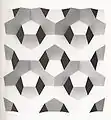Rhombitetraoctagonal tiling
In geometry, the rhombitetraoctagonal tiling is a uniform tiling of the hyperbolic plane. It has Schläfli symbol of rr{8,4}. It can be seen as constructed as a rectified tetraoctagonal tiling, r{8,4}, as well as an expanded order-4 octagonal tiling or expanded order-8 square tiling.
| Rhombitetraoctagonal tiling | |
|---|---|
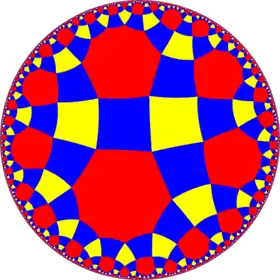 Poincaré disk model of the hyperbolic plane | |
| Type | Hyperbolic uniform tiling |
| Vertex configuration | 4.4.8.4 |
| Schläfli symbol | rr{8,4} or |
| Wythoff symbol | 4 | 8 2 |
| Coxeter diagram | |
| Symmetry group | [8,4], (*842) |
| Dual | Deltoidal tetraoctagonal tiling |
| Properties | Vertex-transitive |
Constructions
There are two uniform constructions of this tiling, one from [8,4] or (*842) symmetry, and secondly removing the mirror middle, [8,1+,4], gives a rectangular fundamental domain [∞,4,∞], (*4222).
| Name | Rhombitetraoctagonal tiling | |
|---|---|---|
| Image |  |
 |
| Symmetry | [8,4] (*842) |
[8,1+,4] = [∞,4,∞] (*4222) |
| Schläfli symbol | rr{8,4} | t0,1,2,3{∞,4,∞} |
| Coxeter diagram |
Symmetry
A lower symmetry construction exists, with (*4222) orbifold symmetry. This symmetry can be seen in the dual tiling, called a deltoidal tetraoctagonal tiling, alternately colored here. Its fundamental domain is a Lambert quadrilateral, with 3 right angles.
 |
 |
| The dual tiling, called a deltoidal tetraoctagonal tiling, represents the fundamental domains of the *4222 orbifold. | |
With edge-colorings there is a half symmetry form (4*4) orbifold notation. The octagons can be considered as truncated squares, t{4} with two types of edges. It has Coxeter diagram ![]()
![]()
![]()
![]()
![]() , Schläfli symbol s2{4,8}. The squares can be distorted into isosceles trapezoids. In the limit, where the rectangles degenerate into edges, an order-8 square tiling results, constructed as a snub tetraoctagonal tiling,
, Schläfli symbol s2{4,8}. The squares can be distorted into isosceles trapezoids. In the limit, where the rectangles degenerate into edges, an order-8 square tiling results, constructed as a snub tetraoctagonal tiling, ![]()
![]()
![]()
![]()
![]() .
.
Related polyhedra and tiling
| *n42 symmetry mutation of expanded tilings: n.4.4.4 | |||||||||||
|---|---|---|---|---|---|---|---|---|---|---|---|
| Symmetry [n,4], (*n42) |
Spherical | Euclidean | Compact hyperbolic | Paracomp. | |||||||
| *342 [3,4] |
*442 [4,4] |
*542 [5,4] |
*642 [6,4] |
*742 [7,4] |
*842 [8,4] |
*∞42 [∞,4] | |||||
| Expanded figures |
 |
 |
 |
 |
 |
 |
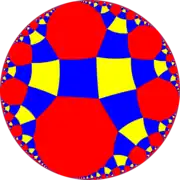 | ||||
| Config. | 3.4.4.4 | 4.4.4.4 | 5.4.4.4 | 6.4.4.4 | 7.4.4.4 | 8.4.4.4 | ∞.4.4.4 | ||||
| Rhombic figures config. |
 V3.4.4.4 |
 V4.4.4.4 |
 V5.4.4.4 |
 V6.4.4.4 |
 V7.4.4.4 |
 V8.4.4.4 |
 V∞.4.4.4 | ||||
| Uniform octagonal/square tilings | |||||||||||
|---|---|---|---|---|---|---|---|---|---|---|---|
| [8,4], (*842) (with [8,8] (*882), [(4,4,4)] (*444) , [∞,4,∞] (*4222) index 2 subsymmetries) (And [(∞,4,∞,4)] (*4242) index 4 subsymmetry) | |||||||||||
= = = |
= |
= = = |
= |
= = |
= |
||||||
 |
 |
 |
 |
 |
 |
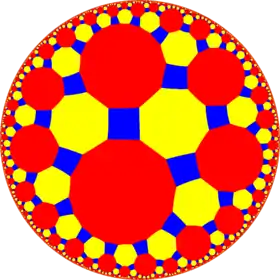 | |||||
| {8,4} | t{8,4} |
r{8,4} | 2t{8,4}=t{4,8} | 2r{8,4}={4,8} | rr{8,4} | tr{8,4} | |||||
| Uniform duals | |||||||||||
 |
 |
 |
 |
 |
 |
 | |||||
| V84 | V4.16.16 | V(4.8)2 | V8.8.8 | V48 | V4.4.4.8 | V4.8.16 | |||||
| Alternations | |||||||||||
| [1+,8,4] (*444) |
[8+,4] (8*2) |
[8,1+,4] (*4222) |
[8,4+] (4*4) |
[8,4,1+] (*882) |
[(8,4,2+)] (2*42) |
[8,4]+ (842) | |||||
= |
= |
= |
= |
= |
= |
||||||
 |
 |
 |
 |
 |
 |
 | |||||
| h{8,4} | s{8,4} | hr{8,4} | s{4,8} | h{4,8} | hrr{8,4} | sr{8,4} | |||||
| Alternation duals | |||||||||||
 |
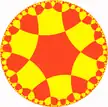 |
 |
 |
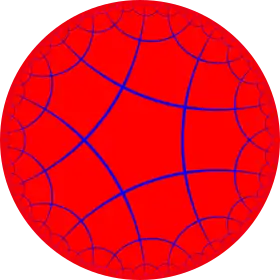 |
|||||||
| V(4.4)4 | V3.(3.8)2 | V(4.4.4)2 | V(3.4)3 | V88 | V4.44 | V3.3.4.3.8 | |||||
References
- John H. Conway, Heidi Burgiel, Chaim Goodman-Strass, The Symmetries of Things 2008, ISBN 978-1-56881-220-5 (Chapter 19, The Hyperbolic Archimedean Tessellations)
- "Chapter 10: Regular honeycombs in hyperbolic space". The Beauty of Geometry: Twelve Essays. Dover Publications. 1999. ISBN 0-486-40919-8. LCCN 99035678.

